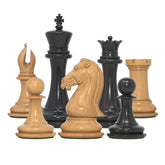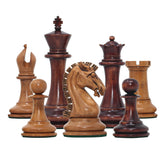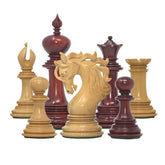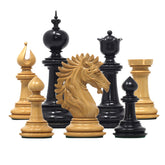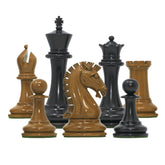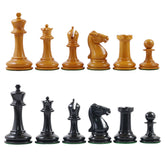THE QUEEN’S GAMBIT OPENING
Chess is a standard board game that is played between two players. The game is played on an eight-by-eight grid called a chessboard. Each player starts with 16 pieces, including one king, one queen, two rooks, two knights, two bishops, and eight pawns.
The players follow some specific rules for each type of piece and take their turns moving the pieces across the board. The game aims to checkmate your opponent's king, which means putting the king in a position where it is attacked and there is no way to rescue it. The king is the most important piece whereas the queen is a powerful piece that can move horizontally, vertically, and diagonally. Rooks move horizontally and vertically, bishops move diagonally, knights have a unique L-shaped move, and pawns move forward but capture diagonally.
THE QUEEN GAMBIT

In the world of chess, the Queen's Gambit opening is a timeless and awesome strategy. It is surely a trick to captivate players and enthusiasts for generations.
In this context, we dig into the art of mastering the Queen's Gambit in chess.It is a roadmap to chess success. Queen Gambit is the most reliable and oldest opening in chess and it is an all-time favorite among grandmasters and of course for new players. It can raise the game to new heights. This content fills you with the tools to reach Queen’s Gambit way and its power for victory on the chess boards. Be the witness to enhance your chess playing abilities to master all the levels.
IMPORTANCE QUEEN'S GAMBIT IN THE GAME OF CHESS
The Queen's Gambit opening begins with moves 1. d4 d5 2. c4. It is seen by white sacrificing a pawn in the center of the board which is specifically the d4 pawn.
Black can accept the gambit by capturing the d4 pawn with their pawn (2...dxc4). The gambit can lead to a sharp and tricky battle. On the other hand black maintains a solid position but gives white more advantage.
The Queen's Gambit is a versatile opening that can lead to a wide range of positions. It has been studied and played at all levels of chess. Its ongoing popularity and its strategic depth offer both players countless possibilities.

THE QUEEN'S GAMBIT HISTORY
The history of the Queen's Gambit opening can be noted in the 15th century in various chess texts.
The opening gained significant attention in
19th century. Players like Adolf Anderssen and Paul Morphy explored its possibilities. The term "Queen's Gambit" was popularized in the mid-19th century as a competitive game.
Emanuel Lasker and José Raúl Capablanca played the Queen's Gambit in high-stakes matches in the 20th century. Grandmasters like Bobby Fischer and Garry Kasparov made it an integral part of modern chess strategy. Today, the Queen's Gambit remains one of chess's most frequently played openings.
THE QUEEN'S GAMBIT AND ITS STARTING POSITION

d4 d5 c4 is the starting position of the Queen Gambit.
In this position, white played move 2. c4, offering a pawn sacrifice known as the Queen's Gambit opening. White is to control the center of the board and create an aggressive and superb game. Black can accept it by capturing the d4 pawn with 2...dxc4 or decline it by making other moves, such as 2...e6 or 2...Nf6.
THE QUEEN'S GAMBIT VARIATIONS
The Queen's Gambit is a gifted opening that gives rise to the game with its unique characteristics and strategic ideas. The three prominent variations of the Queen's Gambit opening are as follows.
SLAV DEFENSE
When Black responds to the Queen's Gambit chess move with 2...c6 the slav defense arises. It controls the d5 square and establishes a sturdy pawn structure. The Slav Defense focuses on the development and a symmetrical pawn structure. It benefits many players due to its high tendencies and high stakes in chess.
QUEEN'S GAMBIT DECLINED
Black declines the gambit by playing 2...e6 in the Queen Gambit Declined. Black maintains a solid position by avoiding the capture of the c4 pawn. It is one of the most lasting and wonderful defenses against the Queen's Gambit. It is also played by various world champions and top players.
QUEEN'S GAMBIT ACCEPTED
When black accepts the gambit with 2...dxc4, the Queen's Gambit accepted occurs. Black aims to gain by capturing the d4 pawn. This variation often shows sharp and tricky positions. The Queen's Gambit Accepted has been played by many players, leading to dynamic and exciting games on the chessboard.
NEED TO KNOW PLAY AGAINST THE QUEEN'S GAMBIT?
Playing against the Queen's Gambit requires a strategic approach and some specific variations. The three popular responses to play against the Queen's Gambit are as follows.
QUEEN'S GAMBIT ACCEPTED
White should prioritize rapid development when facing the Queen Gambit accepted and also try to exploit Black's pawn structure. By focusing on easy development and peace activity. White can create tricky opportunities while blacks must be cautious
SLAV DEFENSE
White can choose from several main lines in response to the Slav Defense (2...c6),. One common approach is to play 3.Nf3, followed by 4.e3, reinforcing the central pawn on d4.The Slav Defense often leads to a slow and strategic struggle.

THE ALBIN COUNTER GAMBIT
The Albin Counter Gambit is a more aggressive response, and White needs to be prepared for Black's counterattacking intentions. If accepting the gambit, White should prioritize development and avoid excessive material greed. If declining, White should focus on solid central control and the harmonious development of pieces.
CONCLUSION
To master the Queen's Gambit opening is a difficult step towards attaining chess success. By understanding strategic opening and its variations through chess notation, players can gain an advantage over their opponents. Accessing these important tools allows you decision-making, increases control, and enhances planning. The Queen's Gambit strengthens and also lays a solid foundation in chess. It is a perfect way to fly in the world of chess.
For more interesting articles visit : www.stauntoncastle.com
Buy Wooden Chess Sets and Pieces : www.stauntoncastle.com
Sample Block Quote
Sample Paragraph Text
- basic rules of chess game
- benefit of playing chess
- benefits of chess game
- Best 10 Chess Opening Books
- best board game for kids
- best chess clock features
- best chess player
- best facts about chess game
- best position in chess
- Chess Champion
- chess classes
- game
- how to buy chess clock
- how to buy chess pieces
- how to play chess
- human chess
- teaching chess to kid
- THE QUEEN’S GAMBIT OPENING


